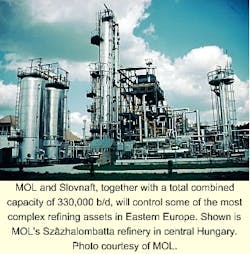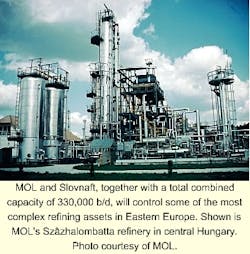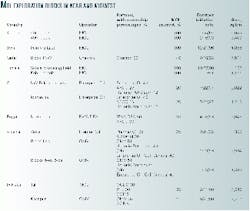MOL Rt. and Slovakia's Slovnaft AS are linking up in the first cross-border consolidation of two former East Bloc petroleum firms.
The deal, which anchors MOL's downstream position, is expected to be approved during the third quarter of this year.
MOL is taking a $262 million initial stake of up to 36.2% in Slovnaft, Slovakia's sole refiner and largest petroleum products retailer. Purchase of existing shares will follow, along with a $150 million increase in Slovnaft's equity. Additional purchase options after 2 years will give MOL the opportunity to acquire 50% plus one share of Slovnaft.
The downstream acquisition lays the groundwork for MOL's strategy in the oil and gas sector.
The Hungarian state company is shifting its overall focus to concentrate on becoming a top refiner-marketer in the region, deepen integration of its petrochemical operations with refining, and sharply consolidate its international upstream holdings.
Regional downstream leader
"This alliance between Slovnaft and MOL will position us as the regional leader in the refining and marketing sector," said former MOL Chairman Janos Csak, who helped broker the deal and later left the company (see related story, p. 31). "[It] is a major step in our announced strategy and is [the] first in a series of initiatives that will position MOL as a driving force in the future regional consolidation." The deal should give the two firms regional downstream dominance as they coordinate their two ambitious service station chain expansion programs and make joint use of Slovnaft's main refinery, which has just undergone a $500 million upgrade.
Slovnaft management said they welcomed the partnership for the experience and financial advantages MOL can bring to their operations. "We were looking for a strong strategic partner and selected MOL based on the close strategic fit, shared objectives in the region, and the company's vast experience in corporate transformation and efficiency improvement," said Slovnaft Pres. and CEO Slavom
Prior to the agreement, Slovnaft was jointly owned by a group led by Stovintegra AS. (51%), which Slovnaft management and employees controlled. The remaining interests were held by Bank of New York (10.5%), Slovbena AS (5.8%), and others (32.7%).
Refinery revamp
Slovnaft's Bratislava refinery was upgraded during 1998-99 to meet European Union air-quality regulations requiring that sulfur content in heavy fuel oil be reduced to 1.0% from 3.5% by the end of 1999.
Although the deadline for that compliance was postponed from the end of 1999 to 2003, other EU-inspired pollution-reducing rule changes have been less clear, and the Bratislava upgrade was designed to anticipate other forthcoming requirements in Slovak fuel and lubricant refining.
New Slovak environmental standards, therefore, have been modeled on German air-quality laws. After the upgrade at Bratislava, sulfur dioxide emissions of fuels must be reduced to 1,200-1,400 mg/cu m from 1,700 mg/cu m in 1999.
MOL's interest in the partnership with Slovnaft-Slovakia's second-largest company by revenues-focuses on downstream, as Slovnaft is primarily an oil refining and marketing company.
The latest production figures (1998) for the Slovnaft refinery totaled 4.4 million tonnes of refined products, 249,100 tonnes of plastics, and 317,800 tonnes of other petrochemical products. Crude oil (5.3 million tonnes) constituted the primary feedstock out of a total of 5.6 million tonnes of feedstock.
In Slovakia, the partly privatized former state firm Nafta, capitalized at $28-million, conducts a number of oil and gas activities. Although considerably smaller than Slovnaft, which has $294 million in capital, the 2,600-employee Nafta is a Slovak upstream oil and gas exploration company that operates more than 500 oil and gas wells and maintains gas storage and transportation facilities. But almost a third of Nafta revenues is in gas extraction and almost half is in gas storage, much of it imported Russian gas.
By comparison, MOL, which is a vertically integrated oil and gas company in neighboring Hungary, a country comparable in size to Slovakia (10 million vs. Slovakia's 9 million inhabitants) had capital value at yearend 1999 of over $2.6 billion, reflecting a longer history of having been publicly traded.
MOL's growing market orientation, now that it is only a quarter state-owned, is news to some Hungarian politicians, who in May cashed in on voter resentment at gasoline price increases by publicly calling for boycotts of the company.
Both MOL and Slovnaft have been acquiring other firms domestically. Following its merger with formerly independent state hydrocarbons trading house Mineralimpex in the mid-1990s, MOL has been building its downstream position, with an extensive service station rehabilitation program and by linking up with Hungarian petrochemical producer TVK.
Slovnaft, meanwhile, acquired the second biggest Slovak service station operator, Benzinol, during 1997-98.
Retail strategy
Branded service stations have been a major feature of both MOL's and Slovnaft's expansion plans. By yearend 1999, Slovnaft was operating 315 service stations in Slovakia and 41 outlets (now 48) in the Czech Republic, the other half of what was, until 1993, the single country Czechoslovakia.
Although Czech and Slovak are different languages, they are related, like Serb and Croat, so the Czech Republic remains a natural choice for Slovnaft expansion abroad.
Slovnaft has said it will focus on Moravia (southern Czech Republic) where it already has 48 service stations, southern Poland (currently 2 stations), and western Ukraine (2 stations) for further service station expansion.
MOL, meanwhile, said it expects to have 150 stations in neighboring countries by 2002, aiming to be seen as the leading oil company in the region.
While Romanian oil company Petrom has 1 station in Szeged, southern Hungary, and plans another 9 in that area, MOL expects to have 80 stations operating in Romania by the end of 2000. The Hungarian firm had 34 in Romania by late 1999.
At home in Hungary, MOL has 330 stations under its MOL 2000 brand name. In other countries, MOL operates 18 service stations in Slovakia, 3 in Ukraine, and 2 in Slovenia, with sales outlets in Croatia also on the way.
Questioned by Hungarian and Slovak journalists in April, MOL officials repeatedly said they had no plans to fuse the two station brand names after their purchase into Slovnaft and saw utility in keeping the chains separate and independent.
Despite apparent savings to be realized from uniting the two, many service station chain mergers have proven more awkward than anticipated in Europe. Furthermore, pride in the distinct national identities of the two national brand names is a sharper issue than in many parts of Europe, although MOL officials were careful to avoid mentioning this second point.
Plastics and petrochemicals
While Slovnaft mainly produces its own basic and intermediate petrochemicals and plastics, MOL sought to further integrate its petrochemical operations by taking a 19.6% stake in TVK in September 1999.
MOL then signed 1-year agreements in January to sell 200,000 tonnes of gas oil to TVK and buy 800 MMcf of hydrogen from TVK. Further, before yearend 2002, MOL will supply TVK with 165,000 tonnes of propylene (almost half of TVK's output), part of over 1 billion tonnes of chemical feedstocks MOL will supply in 2000 alone.
MOL had to deny repeated rumors it was going to take a majority stake in TVK, reflecting perceptions of MOL's increased strength and ambition-and knowledge of TVK's current problems.
TVK, based in eastern Hungary, has experienced a difficult 2 years, losing almost $10 million in 1998 in the derivatives markets, trying unsuccessfully to hedge price movements in naphtha. Late that same year, over $6 million worth of Hungarian government securities were reported as having "disappeared" from TVK's head office.
Nonetheless, the company, which is over 80% privately owned and is Hungary's largest chemical processor, was valued at $323 million in late 1999 and is more committed to free shareholder valuation than most former state enterprises in the region.
A sudden purchase of 28.5% of TVK by Hungary's No. 2 chemical company, BorsodChem, in late May 2000 took analysts by surprise. It prompted a MOL statement that it was quite happy with BorsodChem's purchase of a stake in TVK, believing it was "positive to see the appearance of a strong industrial investor in TVK," even if commentators saw it as frustrating a possible MOL takeover.
Upstream consolidation
Increasing exposure to shareholder interests has quickly matured MOL compared with other regional oil and gas firms, leading it to scale back its bold overseas exploration program.
In place of its wide-ranging cooperative agreements initiated in the late 1990s to explore blocks in Mediterranea nand Middle and Far East countries, MOL now is focusing on a 50-50 partnership with Russian partner Yukos to develop a field in Western Siberia.
The Russian project, and its related oil-transportation infrastructure, is in the Khanty-Mansiysk Autonomous Region, near Nefteyugansk. The field has proven reserves of 175 million bbl. Concentration on this solid upstream project is leading MOL to sell off or withdraw from its other foreign exploration holdings, many of which are already for sale (see table).
MOL has pulled out of the area it was exploring in Turkey, and a private sale currently is in process for its blocks in Tunisia. In addition, a major venture with Chevron Corp. in the Persian Gulf off Qatar, is now lapsing after several dry holes. MOL also is considering whether to continue or abandon its blocks in Albania. This leaves the former Hungarian national petroleum company with sales of interests in five other countries:
- Syria. For sale is the Palmyra East block, northwest of fields with gas reserves totaling up to 350 bcf, with separate rights to export oil and either export gas or sell it locally to Syria's expanding gas-fired power generation sector at a price linked to fuel oil. MOL owns 100% of the block.
- Egypt. MOL is selling its interest in the North Idku block operated by RWE-DEA AG. The package includes a 20% interest in the Jh-51-1 discovery, where 150 bcf of gas has been found and reserves of 10 tcf altogether have been discovered nearby. The area in which MOL is a partner surrounds, but does not include, Abu Qir, Abu Qir North, and Abu Qir West, fields.
- Yemen. Blocks 48 and 49 are still being explored, although MOL estimates an unrisked potential for 1.3 billion bbl of oil there.
- Pakistan. MOL has 35% of Tal and 20% of Khanpur blocks, operated by OMV AG, to divest. Reserves of about 100 million bbl are estimated in an Infra-Cambrian formation in the Suji prospect of Khanpur field.
- Greece. MOL Blocks 4 and 6 are underexplored, but there are hopes for finds in Tertiary compressional traps that are on a structural trend with producing fields to the north in Albania and analogous to Monte Alpi and Val d'Agri giant fields, which Enterprise PLC and Agip SPA discovered to the west in Italy's southern Appenines.
All these divestitures will enable MOL to focus on the former Soviet Union, familiar territory for Hungary's oil and gas industry, both culturally and geologically. The Siberian pilot project cost $8.5 million, and the Hungarians expect to sign a production-sharing agreement with Yukos by the end of 2000.
Ethnic awkwardness overcome
It is particularly encouraging that both Slovnaft and MOL have overcome very delicate ethnic sensitivities in the two neighboring countries to enter into close, commercially reasoned cooperation.
Foreign-relations awkwardness between the two countries, often heightened by nationalist politicians on each side, had made many industry analysts doubt whether the two oil companies could ever work together successfully, however compelling the economic logic.
Although ethnic tension has never been at the explosive levels seen in the Balkans several hundred miles further south, tens of thousands of Slovak-speaking people live inside Hungary, and half a million Hungarian-speaking people live inside Slovakia. This geographic anomaly is a relic of large border changes at the end of World War I that created the state of Czechoslovakia and reduced the size of Hungary by two thirds.
Hungarian MOL's purchase of part of Slovnaft and its upgraded refinery seems, for some nationalist Slovaks, a return of Hungarian influence. When founded as the Apollo refinery in 1895, when the city of Bratislava was within the state of Austro-Hungary, the two official languages of what is now Slovakia's big refinery were then Hungarian and German.
Ethnic differences matter seriously here, with language rights for minorities repeatedly becoming emotional election issues on both sides of the Hungarian-Slovak border.
Already one large energy project-a hydroelectric dam on the Danube to be jointly operated by the two countries at Gabcikovo-Nagymaros-fell afoul of nationalist feelings on both sides. Hungary pulled out of the joint project in the early 1990s, and began to criticize Slovakia (then newly independent from the Czech Republic in 1993) for causing water-table damage inside Hungary by diverting the Danube.
Power from the hydroelectric dam might have been sufficient to make it the single largest energy supplier in both countries, so the power of ethnic irritability here to also derail substantial real-world energy projects should not be underestimated.
In mid-1999, talks between MOL and Slovnaft appeared to have broken down irretrievably. MOL board members were astute enough to publicly proclaim the deal with Slovnaft no longer viable, probably to give Slovnaft chiefs time to quietly build support for cooperation with the Hungarians while unencumbered by nationalist opposition within Slovakia.
MOL instead stated that it was close to an agreement with INA, the Croatian oil and gas company that controls the Adria pipeline-one of Hungary's two links to the western oil grid.
Simply calculating on cultural grounds, most observers halfway through last year expected the INA deal to succeed where a MOL-Slovnaft linkup appeared to have failed.
No comparable tension exists between Hungary and Croatia traditionally, and in the early days of the Yugoslavia break-up, the Hungarian government was even accused of being on the Croatian side against the Serbs-allegedly for selling weaponry to Zagreb.
A link-up with INA for MOL seemed far more likely to succeed, by going with, rather than against, the cultural grain.
MOL's ability to buy into Slovnaft therefore is an extremely hopeful sign for the region. It shows that, at least two large firms and their accompanying political cultures seem to have been able to put commercial logic ahead of nationalist sentiment in a part of Europe where the opposite is still far more common.



